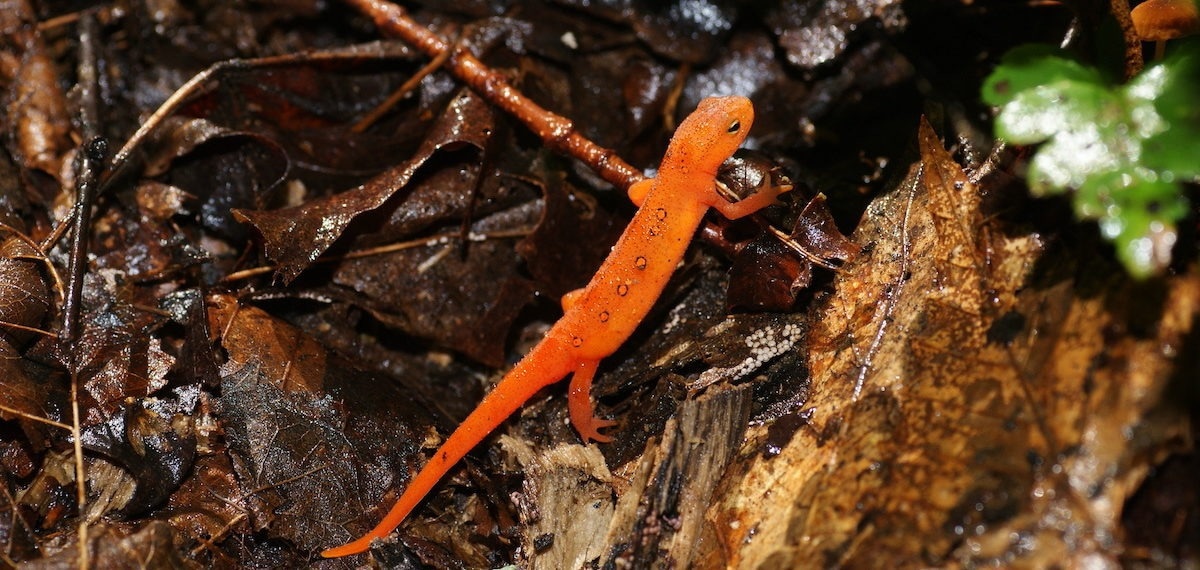Recent studies show that amphibian biodiversity could suffer significantly if the fungus infection Batrachochytrium salamandrivorans (Bsal) was introduced to North America. The findings from a team of researchers from Washington State University, the University of Massachusetts-Boston, and the University of Tennessee Institute of Agriculture were published on June 5th, 2023 in Nature Communications.
 A juvenile eastern newt (Notophthalmus viridescens) traversing the Appalachian landscape. Eastern newts are among the most susceptible species tested to Bsal chytridiomycosis. Image Credit: A. Hertz, University of Massachusetts Boston, used by permission.
A juvenile eastern newt (Notophthalmus viridescens) traversing the Appalachian landscape. Eastern newts are among the most susceptible species tested to Bsal chytridiomycosis. Image Credit: A. Hertz, University of Massachusetts Boston, used by permission.
We could see over 80 species of salamanders in the United States and 140 species in North America experience population declines if Bsal is introduced.”
Matt Gray, Study Lead Author and Professor, Wildlife Health, School of Natural Resources, University of Tennessee
Amphibians play a significant role in the environment’s natural mosquito control. Because of their capacity for limb regeneration and the natural analgesics, or painkillers, they create, they are also significant for medical research. Some of the peptides from their skin can inactivate HIV and other viruses harmful to humans.
The skin of amphibians, however, is eroded and destroyed by Bsal. The fungus-based infection was identified in European fire salamander populations ten years ago, but it has not been found in the western hemisphere as of yet. In 2016, the authors of the article started conducting tests to determine the danger to amphibians in North America.
Gray added, “Some of our most common salamander species, like the eastern newt, could be wiped out.”
The study indicates that the greatest decreases would occur in the Appalachian Mountains and the Pacific Northwest, where climate conditions are optimal for Bsal and salamander populations.
Many of the salamanders in the Smokies are lungless and breath entirely through their skin. So, a fungus that destroys the skin can affect their ability to respire and maintain healthy levels of important electrolytes in their bodies.”
Debra Miller, Study Co-Author and Veterinary Pathologist, One Health Initiative, University of Tennessee
Miller and colleagues showed that the Bsal infection could cause changes in skin function and electrolytes in the blood, which can result in paralysis. This has been frequently observed in sick animals.
The authors of the Nature article urge the United States, Canada, and Mexico to think about creating a program for healthy trade certification that would support the sale of amphibians free of ranaviruses and chytrid fungi. According to the publication, the wildlife trade produces $300 billion annually and involves more than 180 nations.
The majority of U.S. corporations support a healthy trade certification program, according to a different study by Kevin Cavasos of the UT One Health Initiative, Gray, and colleagues, which was published in June in Business Strategy and the Environment.
Our initial surveys of pet amphibian owners suggest they are concerned about these pathogens and may be willing to spend approximately 75% more for amphibians that are not infected.”
Neelam Poudyal, Professor, Natural Resource Policy, School of Natural Resources, University of Tennessee
Recently, Gray, Poudyal, and others started a project funded by the National Science Foundation to look at the mobility of pathogens in the pet amphibian trade and the industry’s desire to embrace ethical trade procedures.
Gray added, “Wildlife trade can contribute to the global spread of various pathogens, even those that can cause disease in humans. It is important to support healthy trade programs to reduce business losses and threats to our native biodiversity and safeguard public health.”
Source:
Journal references:
Gray, M. J., et al. (2023). Broad host susceptibility of North American amphibian species to Batrachochytrium salamandrivorans suggests high invasion potential and biodiversity risk. Nature Communications. doi.org/10.1038/s41467-023-38979-4
Sheley, W. C., et al. (2023). Electrolyte imbalances and dehydration play a key role in Batrachochytrium salamandrivorans chytridiomycosis. Frontiers in Veterinary Science. doi.org/10.3389/fvets.2022.1055153
Cavasos, K., et al. (2023). Exploring business stakeholder engagement in sustainable business practices: Evidence from the US pet amphibian industry. Business Strategy and the Environment. doi.org/10.1002/bse.3455